My Inbox Helper (Removal Instructions) - updated Jun 2021
My Inbox Helper Removal Guide
What is My Inbox Helper?
My Inbox Helper is the browser plugin that rarely gets installed willingly by the user
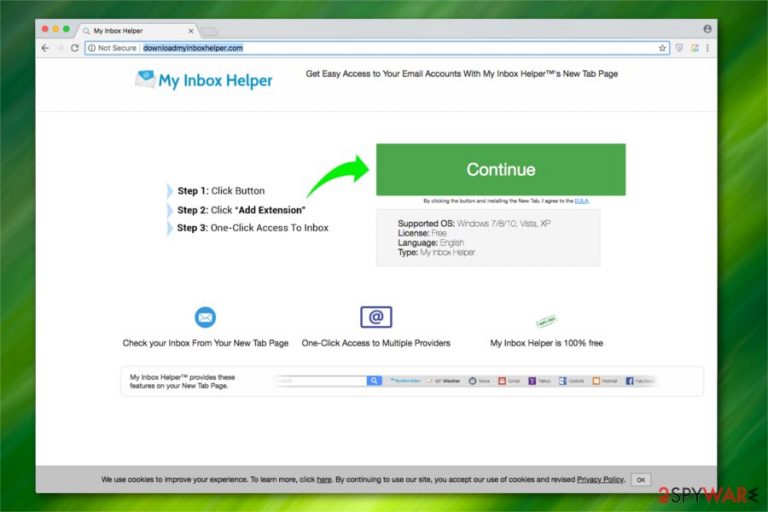
My Inbox Helper is a potentially unwanted program (PUP)[1] that usually gets installed together with freeware or shareware obtained from the internet. Once inside, it hijacks Google Chrome, Internet Explorer, Mozilla Firefox, Safari, or another browser, and changes the new tab address and the startup page.
This way, users are forced to browse through a search engine powered by an unwanted application. While all the search results generated through the questionable site, it directs users to Yahoo, the page is littered with sponsored links. This is done to increase the profits to browser hijacker authors, as both parties benefit from commercial ads via the pay-per-click[2] revenue.
| Name | My Inbox Helper |
|---|---|
| Type | Browser hijacker |
| Sub-type | Potentially Unwanted Program (PUP) |
| Developer | Eightpoint Technologies Ltd (affiliate of the infamous Polarity Technologies) |
| Compatible OS | Windows 7/8/10/Vista/XP |
| Advertised as | A useful tool to help users access email accounts and other websites easily |
| Distribution | Spreads as a browser extension which might come inside software-bundles |
| Symptoms | It hijacks the targeted browser and modifies its settings to change the new tab page |
| Removal | Use security software or terminate the PUP manually with the help of our removal instructions |
| recovery & Optimization | Use FortectIntego to make sure your computer is running well after the infection |
In some cases, My Inbox Helper might be installed intentionally – either from the Chrome web store or the official website. Allegedly, the browser extension created by Eightpoint Technologies Ltd offers all the quick access links to Gmail, Outlook, and other email services. However, these links can be created just as easily via bookmarks, so there is no need for a browser hijacker to be installed in the first place.
My Inbox Helper is created with one thought in mind: generate ad revenue while diminishing users' web browsing experience, gather a variety of non-personally identifiable information[3] about them, and expose them to potentially harmful content on the internet (such as phishing, spoofed, scam or even malware-laden sites).
Once the hijack occurs, users' start page looks quite a bit different than a normal Google homepage. It includes a variety of links that all allegedly should help users entering their emails easier, and also prompts them to download other questionable applications, such as Search Encrypt. Additionally, users can spot the added toolbar at the top of the browser window.
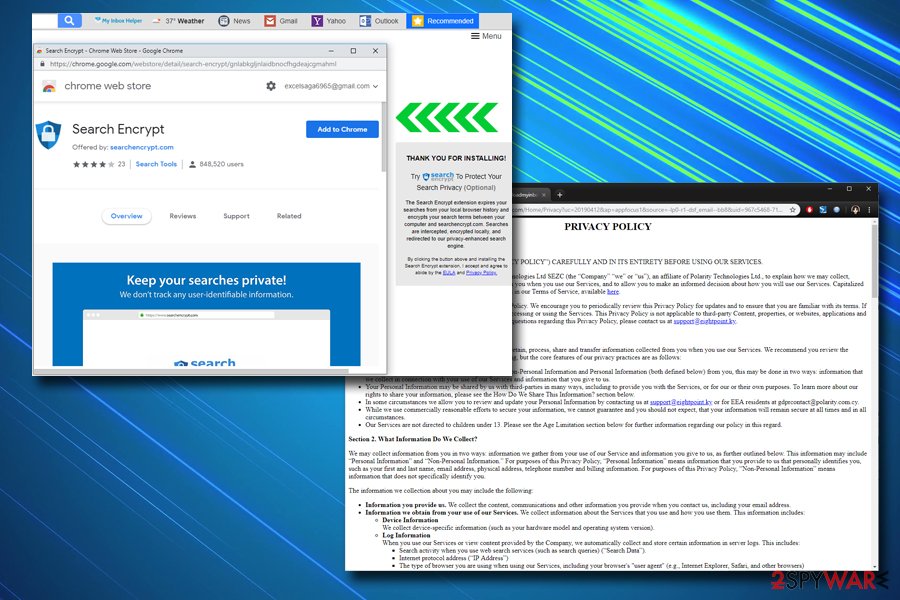
While the app has many intrusive qualities, we cannot use the My Inbox Helper virus term as this application is not malicious itself. Despite that, experts categorize it as a potentially unwanted program (PUP) since it might spy on its users and record non-personally identifiable information for advertising purposes.
Usually, after My Inbox Helper gets installed, it starts monitoring the following details from the affected device:
- IP address;
- ISP;
- Geographic location;
- Clicked ads;
- Browser history;
- Chrome extensions enabled
- Search activity, etc.
According to the Privacy Policy, this data can be shared with affiliated companies:
We may share your information with our parent company and our affiliates, which are entities under common ownership or control of our ultimate parent company
This information allows My Inbox Helper to deliver customized ads to its users. In other terms, it modifies them to suit your interests and increases the chances of you clicking the advertisements. However, some details might include private information, such as an email address, if you type it in your search queries.
Likewise, despite what the reviews claim, you should protect your system and get rid of this browser hijacker. Note that the new search engine can deliver altered search results and lead you to affiliate sites or even malware distribution sources.
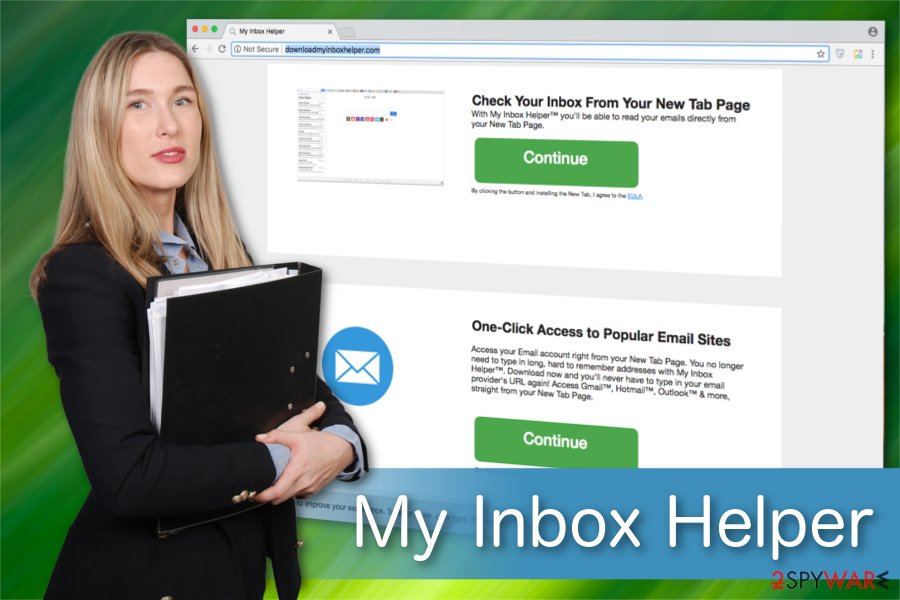
If you still have doubts about the removal, experts[4] warn that the ads this program generates might include malicious scripts. In other terms, if you click on a bogus ad, it can trigger an automatic installation of malware. Likewise, do not hesitate and remove the threat by using security software or terminate the threat manually with the help of our removal instructions below. Additionally, we recommend scanning your device with SpyHunter 5Combo Cleaner or Malwarebytes to get rid of the infection.
Suspicious browser extensions can be bundled with freeware
Users can download this potentially unwanted program (PUP) directly from its website. However, developers also use the bundling technique to distribute this questionable browser extension[5] together with freeware. If you want to reveal all the components of the software bundle to reject suspicious extensions, you should follow these steps:
- Read Privacy Policy, EULA, and Terms of Use;
- Change Quick/Recommended installation mode to Custom/Advanced;
- Do not skip any steps and read the provided information;
- Opt-out pre-selected components which suggest initiating changes in your browser.

Additionally, users should also install reputable security applications to keep their machines safe from other, more serious infections, such as ransomware, spyware, banking trojans, info-stealers, etc.
My Inbox Helper PUP uninstall guide
Users who want to remove the infection from their systems can choose between two elimination methods. They can either get rid of this browser hijacker manually by following the instructions at the end of this article or install a reliable antivirus and perform automatic My Inbox Helper removal.
Either way, you will need to reset each of the affected browsers. You can find detailed guidelines showing how to delete suspicious extensions from Google Chrome, Internet Explorer, Mozilla Firefox, and Microsoft Edge below. Additionally, experts list the three best antivirus software to deal with PUPs below as well.
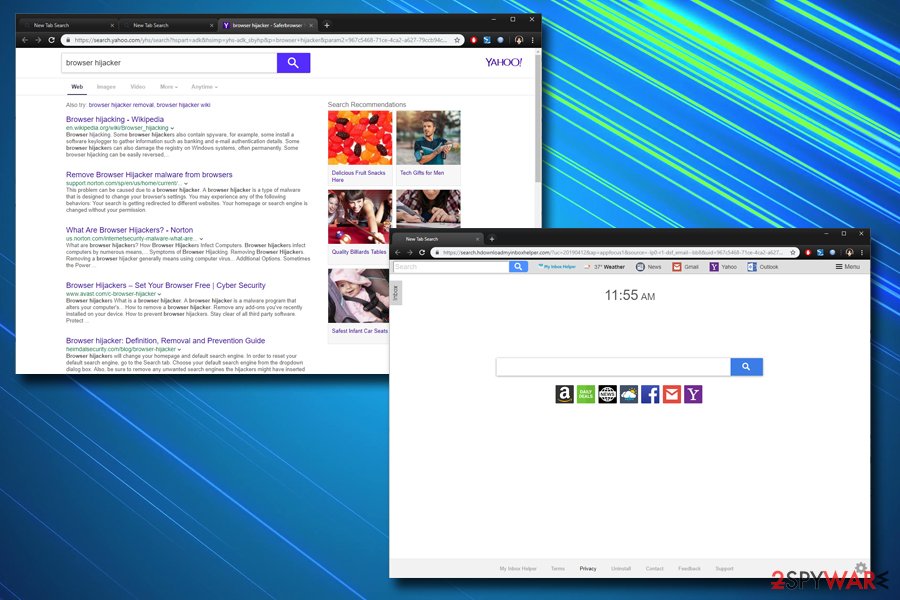
You may remove virus damage with a help of FortectIntego. SpyHunter 5Combo Cleaner and Malwarebytes are recommended to detect potentially unwanted programs and viruses with all their files and registry entries that are related to them.
Getting rid of My Inbox Helper. Follow these steps
Uninstall from Windows
Instructions for Windows 10/8 machines:
- Enter Control Panel into Windows search box and hit Enter or click on the search result.
- Under Programs, select Uninstall a program.

- From the list, find the entry of the suspicious program.
- Right-click on the application and select Uninstall.
- If User Account Control shows up, click Yes.
- Wait till uninstallation process is complete and click OK.

If you are Windows 7/XP user, proceed with the following instructions:
- Click on Windows Start > Control Panel located on the right pane (if you are Windows XP user, click on Add/Remove Programs).
- In Control Panel, select Programs > Uninstall a program.

- Pick the unwanted application by clicking on it once.
- At the top, click Uninstall/Change.
- In the confirmation prompt, pick Yes.
- Click OK once the removal process is finished.
Remove from Microsoft Edge
Delete unwanted extensions from MS Edge:
- Select Menu (three horizontal dots at the top-right of the browser window) and pick Extensions.
- From the list, pick the extension and click on the Gear icon.
- Click on Uninstall at the bottom.
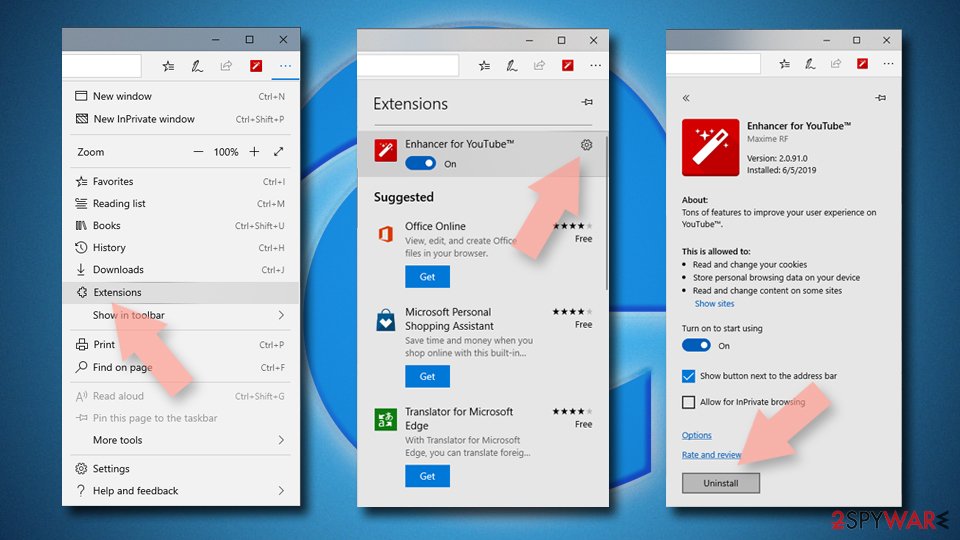
Clear cookies and other browser data:
- Click on the Menu (three horizontal dots at the top-right of the browser window) and select Privacy & security.
- Under Clear browsing data, pick Choose what to clear.
- Select everything (apart from passwords, although you might want to include Media licenses as well, if applicable) and click on Clear.
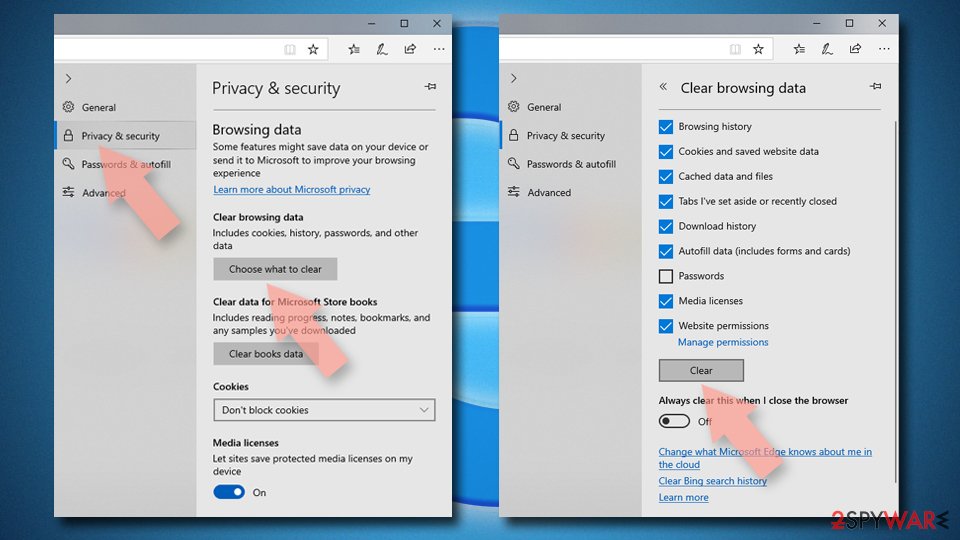
Restore new tab and homepage settings:
- Click the menu icon and choose Settings.
- Then find On startup section.
- Click Disable if you found any suspicious domain.
Reset MS Edge if the above steps did not work:
- Press on Ctrl + Shift + Esc to open Task Manager.
- Click on More details arrow at the bottom of the window.
- Select Details tab.
- Now scroll down and locate every entry with Microsoft Edge name in it. Right-click on each of them and select End Task to stop MS Edge from running.
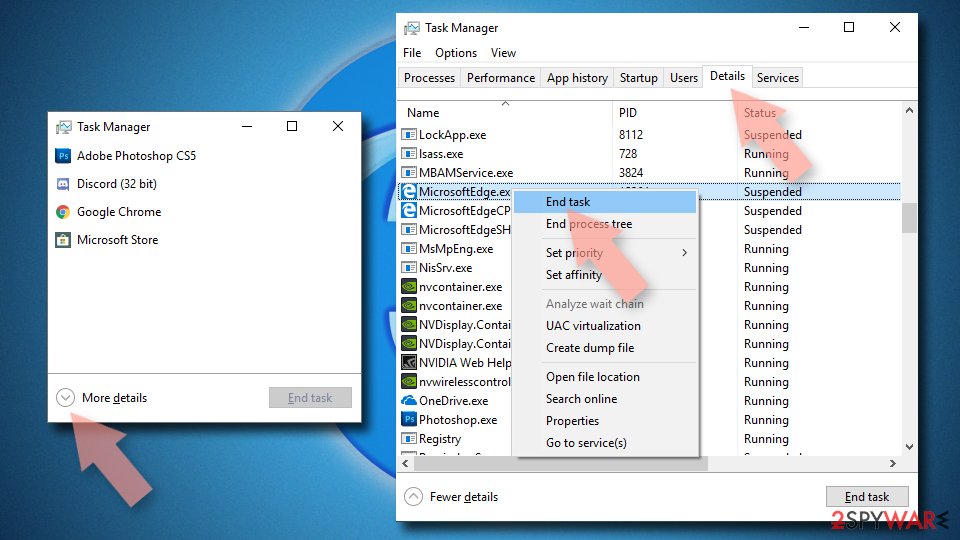
If this solution failed to help you, you need to use an advanced Edge reset method. Note that you need to backup your data before proceeding.
- Find the following folder on your computer: C:\\Users\\%username%\\AppData\\Local\\Packages\\Microsoft.MicrosoftEdge_8wekyb3d8bbwe.
- Press Ctrl + A on your keyboard to select all folders.
- Right-click on them and pick Delete

- Now right-click on the Start button and pick Windows PowerShell (Admin).
- When the new window opens, copy and paste the following command, and then press Enter:
Get-AppXPackage -AllUsers -Name Microsoft.MicrosoftEdge | Foreach {Add-AppxPackage -DisableDevelopmentMode -Register “$($_.InstallLocation)\\AppXManifest.xml” -Verbose

Instructions for Chromium-based Edge
Delete extensions from MS Edge (Chromium):
- Open Edge and click select Settings > Extensions.
- Delete unwanted extensions by clicking Remove.
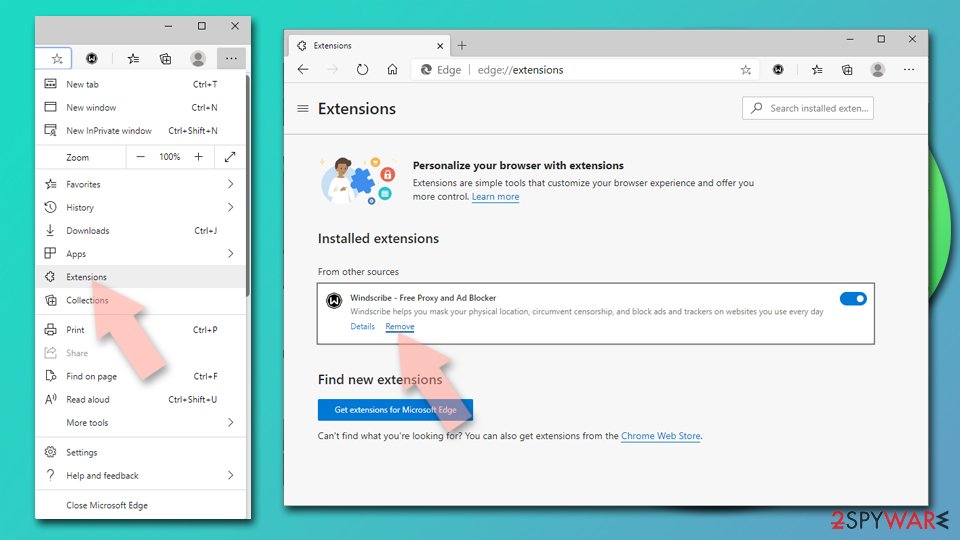
Clear cache and site data:
- Click on Menu and go to Settings.
- Select Privacy, search and services.
- Under Clear browsing data, pick Choose what to clear.
- Under Time range, pick All time.
- Select Clear now.
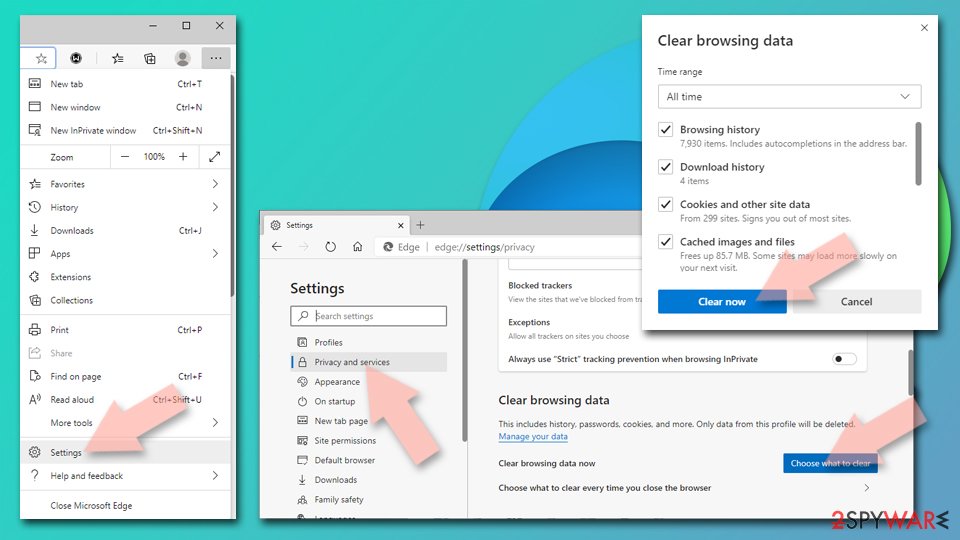
Reset Chromium-based MS Edge:
- Click on Menu and select Settings.
- On the left side, pick Reset settings.
- Select Restore settings to their default values.
- Confirm with Reset.
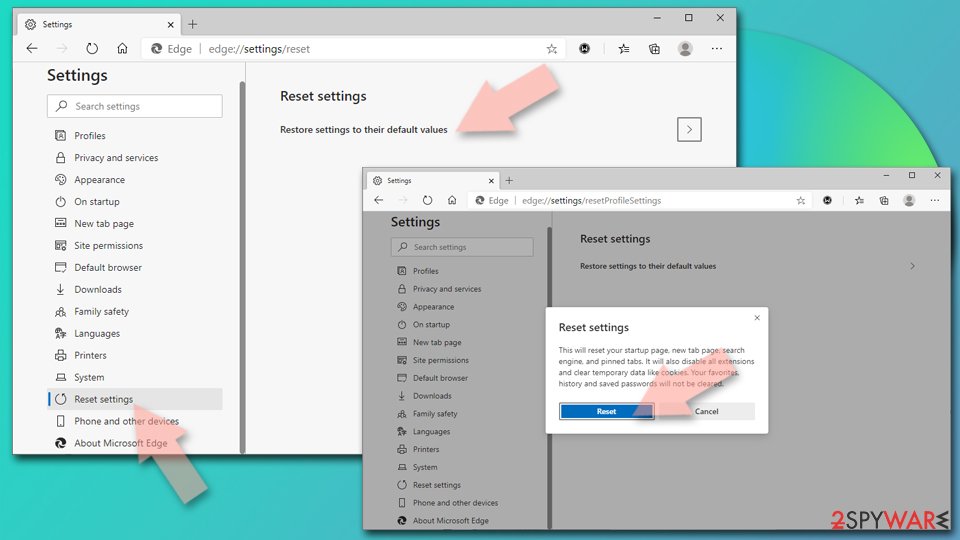
Remove from Mozilla Firefox (FF)
Remove dangerous extensions:
- Open Mozilla Firefox browser and click on the Menu (three horizontal lines at the top-right of the window).
- Select Add-ons.
- In here, select unwanted plugin and click Remove.

Reset the homepage:
- Click three horizontal lines at the top right corner to open the menu.
- Choose Options.
- Under Home options, enter your preferred site that will open every time you newly open the Mozilla Firefox.
Clear cookies and site data:
- Click Menu and pick Settings.
- Go to Privacy & Security section.
- Scroll down to locate Cookies and Site Data.
- Click on Clear Data…
- Select Cookies and Site Data, as well as Cached Web Content and press Clear.
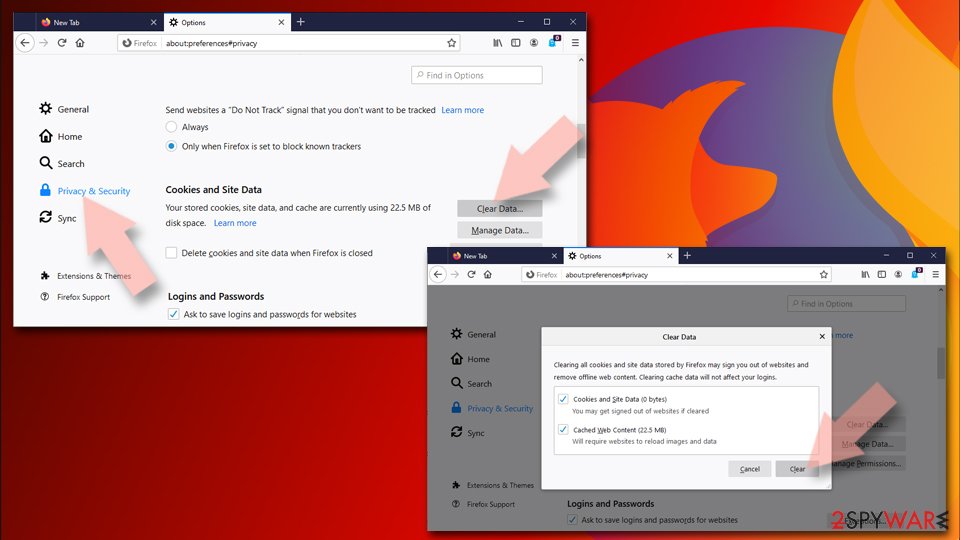
Reset Mozilla Firefox
If clearing the browser as explained above did not help, reset Mozilla Firefox:
- Open Mozilla Firefox browser and click the Menu.
- Go to Help and then choose Troubleshooting Information.
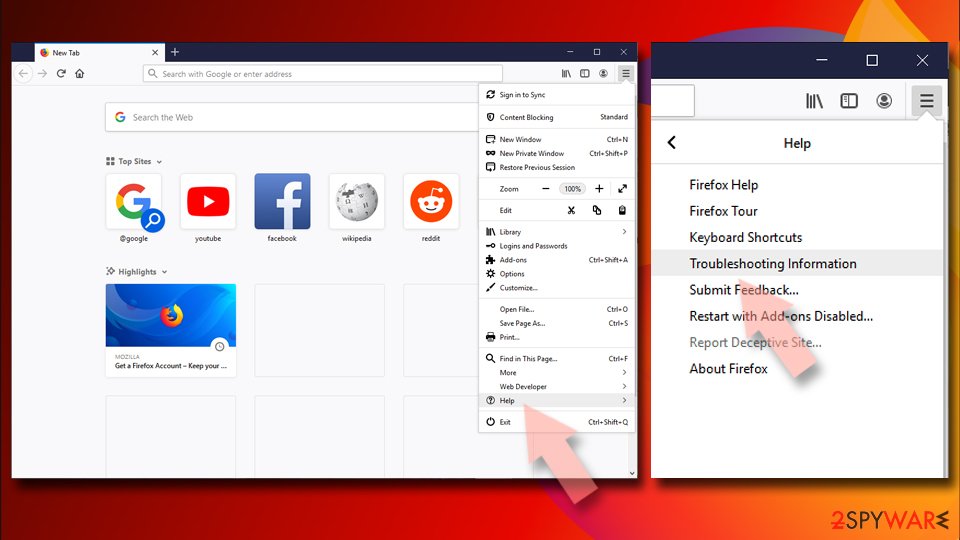
- Under Give Firefox a tune up section, click on Refresh Firefox…
- Once the pop-up shows up, confirm the action by pressing on Refresh Firefox.
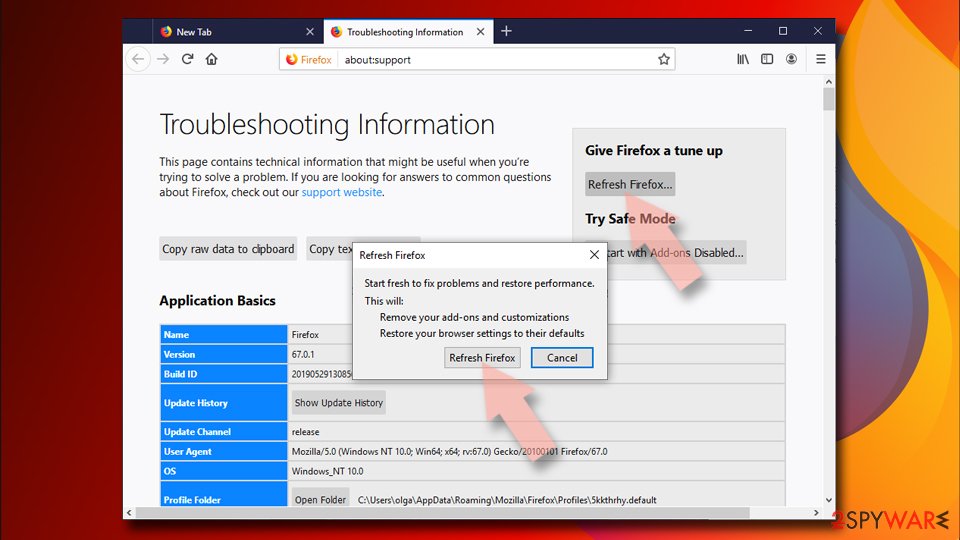
Remove from Google Chrome
Delete malicious extensions from Google Chrome:
- Open Google Chrome, click on the Menu (three vertical dots at the top-right corner) and select More tools > Extensions.
- In the newly opened window, you will see all the installed extensions. Uninstall all the suspicious plugins that might be related to the unwanted program by clicking Remove.

Clear cache and web data from Chrome:
- Click on Menu and pick Settings.
- Under Privacy and security, select Clear browsing data.
- Select Browsing history, Cookies and other site data, as well as Cached images and files.
- Click Clear data.

Change your homepage:
- Click menu and choose Settings.
- Look for a suspicious site in the On startup section.
- Click on Open a specific or set of pages and click on three dots to find the Remove option.
Reset Google Chrome:
If the previous methods did not help you, reset Google Chrome to eliminate all the unwanted components:
- Click on Menu and select Settings.
- In the Settings, scroll down and click Advanced.
- Scroll down and locate Reset and clean up section.
- Now click Restore settings to their original defaults.
- Confirm with Reset settings.
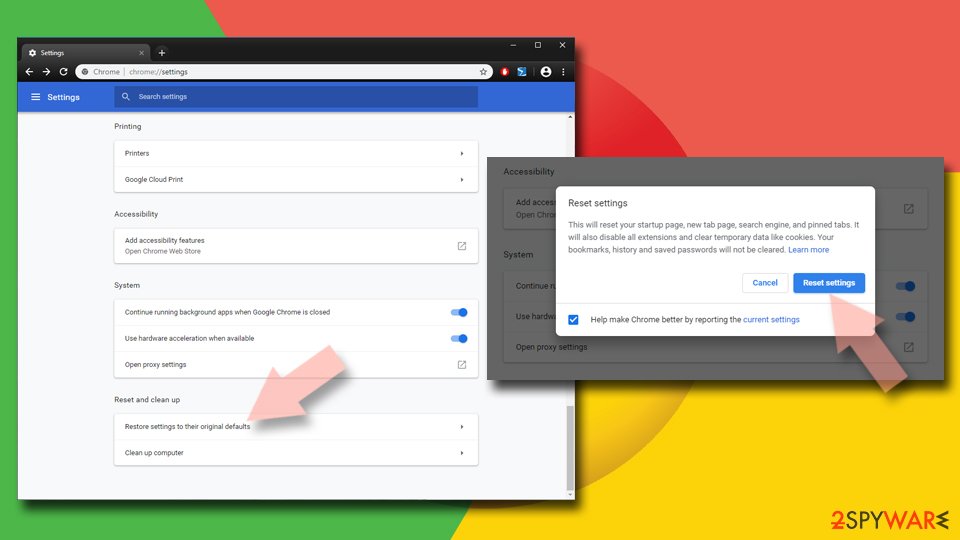
After uninstalling this potentially unwanted program (PUP) and fixing each of your web browsers, we recommend you to scan your PC system with a reputable anti-spyware. This will help you to get rid of My Inbox Helper registry traces and will also identify related parasites or possible malware infections on your computer. For that you can use our top-rated malware remover: FortectIntego, SpyHunter 5Combo Cleaner or Malwarebytes.
How to prevent from getting browser hijacker
Protect your privacy – employ a VPN
There are several ways how to make your online time more private – you can access an incognito tab. However, there is no secret that even in this mode, you are tracked for advertising purposes. There is a way to add an extra layer of protection and create a completely anonymous web browsing practice with the help of Private Internet Access VPN. This software reroutes traffic through different servers, thus leaving your IP address and geolocation in disguise. Besides, it is based on a strict no-log policy, meaning that no data will be recorded, leaked, and available for both first and third parties. The combination of a secure web browser and Private Internet Access VPN will let you browse the Internet without a feeling of being spied or targeted by criminals.
No backups? No problem. Use a data recovery tool
If you wonder how data loss can occur, you should not look any further for answers – human errors, malware attacks, hardware failures, power cuts, natural disasters, or even simple negligence. In some cases, lost files are extremely important, and many straight out panic when such an unfortunate course of events happen. Due to this, you should always ensure that you prepare proper data backups on a regular basis.
If you were caught by surprise and did not have any backups to restore your files from, not everything is lost. Data Recovery Pro is one of the leading file recovery solutions you can find on the market – it is likely to restore even lost emails or data located on an external device.
- ^ Margaret Rouse. PUP (potentially unwanted program). SearchSecurity. TechTarget.
- ^ What is pay per click?. Brick Marketing. Full Service SEO Solutions Firm.
- ^ Non (Personally Identifiable Information) PII Data. Latent View. Digital analytics firm.
- ^ Browser extension. Wikipedia. The Free Encyclopedia.
- ^ BedyNet. BedyNet. Security and Spyware News.
